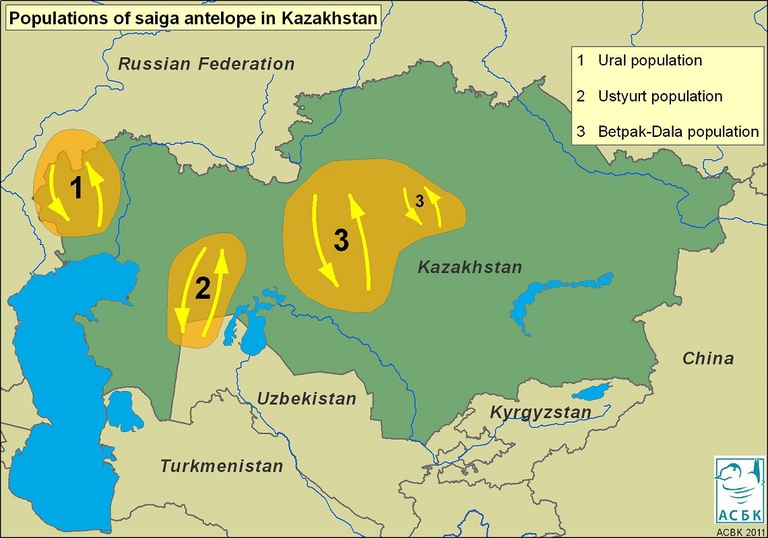
Refusing the anthropocentric vision and respecting the laws of ecology is the only way to safeguard the future of our and all other species, Sea Shepherd President Paul Watson argues in this op-ed.
Dopo l’inspiegabile moria che lo scorso anno aveva ucciso metà dell’intera popolazione dell’Asia centrale, il numero di esemplari è tornato a crescere.
A mysterious epidemic decimated saiga populations (Saiga tatarica) in Kazakhstan last year, from mid-May to early June. More than 200,000 individuals of this rare antelope species died over just a few weeks, cutting to half the endangered population of central Asia.
The causes of the epidemic – which killed the animals within a few hours from the onset of symptoms such as diarrhoea and respiratory crises – are still unclear, but scientists argue it was due to bacterial infection.
The epidemic represented a severe blow to this tiny, funny antelope, which has been roaming the Earth since the Ice Age. The saiga is listed as Critically Endangered by the IUCN Red List of Threatened Species since 2002 and, before the die-off it was mainly threatened by poaching (for meat and males’ horns) and habitat loss.
Despite saiga populations dropped by 95 per cent over the past decades, it seems that these mammals don’t feel like becoming extinct. A recent study, carried out from April 18 to May 3, revealed that the numbers of all three saiga populations in Kazakhstan are going up.
“The news about recovering saiga populations in Kazakhstan is a sign of hope after the catastrophic mass saiga die-off event in 2015,” said Bradnee Chambers, Executive Secretary of the Convention on Migratory Species (CMS).
The research, conducted by the Ministry of Agriculture of the Republic of Kazakhstan in partnership with the Association for the Conservation of Biodiversity of Kazakhstan (ACBK), counted a total of 108,300 adult saigas. The Ural population has about 70,200 individuals, up from 51,700 in 2015, while the Ustyurt population has around 1,900 individuals, up from 1,200 in 2015. The third population (Betpak-Dala) has about 36,200 individuals. “This is far below the 242,000 animals we counted in spring 2015, before the mass-die off,” said Albert Salemgareyev, biologist from ACBK. “But we are grateful for this glimpse of hope.”
Siamo anche su WhatsApp. Segui il canale ufficiale LifeGate per restare aggiornata, aggiornato sulle ultime notizie e sulle nostre attività.
![]()
Quest'opera è distribuita con Licenza Creative Commons Attribuzione - Non commerciale - Non opere derivate 4.0 Internazionale.
Refusing the anthropocentric vision and respecting the laws of ecology is the only way to safeguard the future of our and all other species, Sea Shepherd President Paul Watson argues in this op-ed.
Climate change is the direct consequence of global warming. Here’s everything you need to know about the causes and effects of one of the biggest threats facing our time.
Secondo un nuovo studio pubblicato su Science Advances i paesaggi forestali intatti stanno scomparendo ad un ritmo insostenibile.
La Giornata mondiale dell’alimentazione 2016 è dedicata al terribile impatto dei cambiamenti climatici sulla nostra sicurezza alimentare.
A causa della caccia e della guerra civile in Congo questa specie è ora classificata “in pericolo critico” dalla Lista rossa della Iucn.
Lo sbiancamento avrebbe ucciso il 35 per cento dei coralli che compongono il sito australiano classificato Patrimonio mondiale dell’Umanità.
The government of Indonesia has declared a new moratorium on the expansion of the palm oil and mining industries in the Leuser ecosystem. This area, located on the island of Sumatra, is the last place on Earth where Sumatran orangutans, tigers, rhinos and elephants coexist in the wild. As well as being a biodiversity hotspot,
Leonardo DiCaprio is unstoppable, and so is his commitment to protecting the environment, even if it may cost him being banned from Indonesia. The country’s government was angered by a series of photographs the Oscar-winning actor posted on social media. These were taken during his visit to Gunung Leuser National Park in the province of
With verdant and pristine rainforests and high peaks, the Gunung Leuser National Park, Indonesia, is a real treasure for biodiversity. It is home to species still unknown to science and, above all, it is the last place on Earth where Sumatran orangutans, elephants, bears, and rhinos roam freely in the wild. The lowland #rainforest of the








